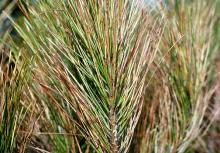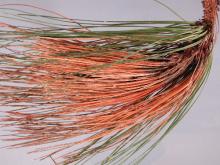Cause Dothistroma septosporum (sexual: Mycosphaerella pini), a fungus reported in Oregon, Idaho and British Columbia. Dothistroma pini is found mostly in the North Central United States but has been reported from Idaho. The red band disease has caused serious losses in some Christmas tree plantings of hard pine (two- and three-needle pines), Scots pine (Pinus sylvestris), Austrian pine (P. nigra), and shore or lodgepole pine (P. contorta), as well as in plantations of lodgepole pine in BC. Five-needle pines also are reported to be susceptible. The fungus attacks both current-season needles and needles produced in past seasons. Black, asexual fungal structures (stroma) mature 1 to 2 years after initial infection. Spores produced within the stroma are spread, mostly by rain and only up to 6.5 ft, to cause new infections. Usually by mid-August all spores have been disseminated. Spores germinate under moist conditions and penetrate stomata. A toxin, dothistromin, diffuses into the tissue ahead of the fungus, killing plant cells. The fungus can persist in cast needles longer if the needles are suspected or caught up in the canopy when compared to infected needles that fall onto the forest floor.
Symptoms Chlorotic spots on infected needles in fall and winter. Spots gradually spread, turn red-brown, and girdle the needles, killing the distal end while the base stays green. In early spring, a black fungal growth (stromata) erupts through the needle epidermis. Affected trees may defoliate during the growing season, rendering the trees useless for sale. Reduced growth rate is another result of annual defoliation.
Can easily be confused with other needle cast diseases. Needle cast diseases are identified by microscopically examining fruiting bodies and spores. Needle casts can also be confused with annual (normal) fall needle drop. Most conifers shed some of their oldest needles in the fall. These old needles often turn yellow or brown before falling off.
Cultural control
- Avoid using seed from susceptible (off-site) tree sources.
- Prune the lowest whorl of branches at first opportunity.
- For high-value trees, remove and destroy fallen needles that collect in branch crotches and on the ground. Avoid planting in low-lying areas with poor air drainage.
- Space plants for good air circulation.
- Forest trees-thinning stands is helpful.
- Reduce the density of susceptible species in a stand.
- Control weeds and vegetation around the bases of trees.
- Shear Christmas trees during dry weather.
Chemical control Apply just before budbreak and again a few weeks later.
- Bordeaux 8-8-100. Can be toxic to new needles. Group M1 fungicide. O
- Bravo Weather Stik at 5.5 pints/A. Group M5 fungicide. 12-hr reentry.
- Echo 720 at 5.5 pints/A. Group M5 fungicide. 12-hr reentry.
- Ortho MAX Garden Disease Control at 5 teaspoons/4 gal water. H
- Penncozeb 75 DF at 2 to 4 lb/A. Registered for use on Christmas trees. Group M3 fungicide. 24-hr reentry.
- Phyton 27 at 1.5 to 2 oz/10 gal water is registered for nursery crops. Group M1 fungicide. 48-hr reentry.
References Boateng, K., and Lewis, K. J. 2015. Spore dispersal by Dothistroma septosporum in northwest British Columbia. Phytopathology 105:69-79.
Mullett, M., Peace, A., and Brown, A. 2016. Persistence of Dothistroma septosporum on abscised pine needles and its implications for disease management. Plant Disease 100:1271-1277.




